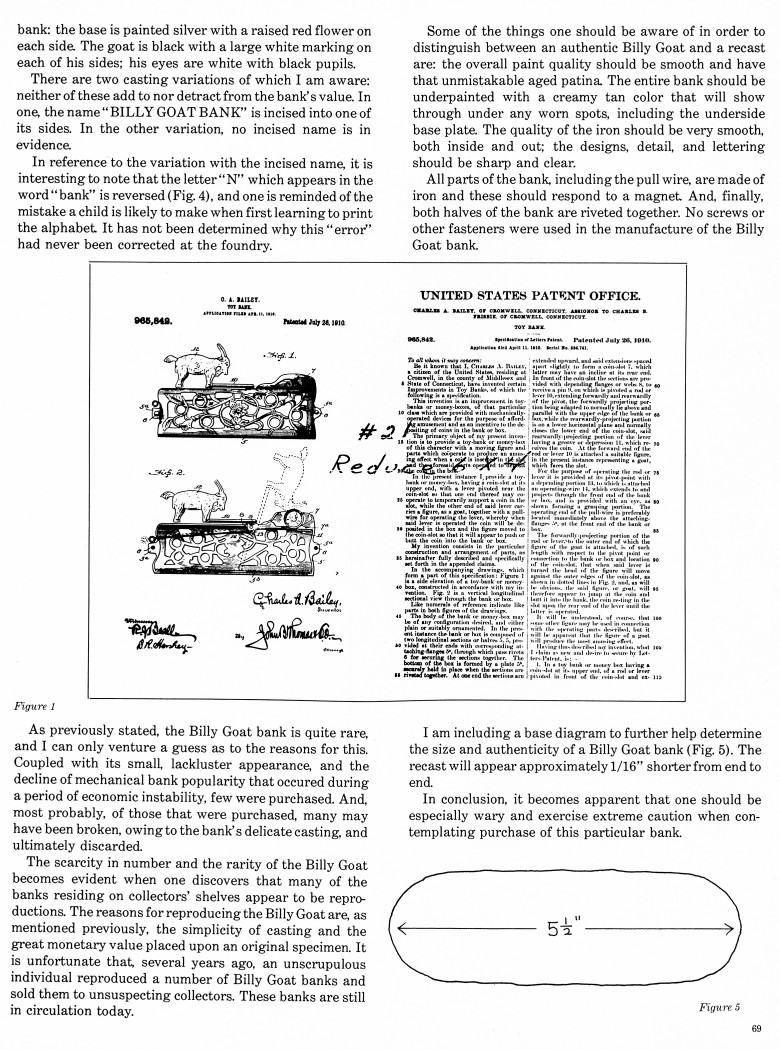|
The Billy Goat Bank
by Sy Schreckinger – ANTIQUE TOY WORLD Magazine – October, 1983
This
article will be devoted to a mechanical bank which is considered to be
quite rare, although underrated and undervalued. The "Billy Goat" bank is
small in size, monochromatic, and lacks exciting action - factors which
have contributed to its underestimation. However, I am of the opinion that
this tiny bank is one to be appreciated, and especially for its simplicity
and graceful design.
The Billy Goat's simple, graceful proportions and delicate floral
designs pay tribute to the most prestigious of all mechanical bank
designers - Charles A. Bailey. This innovative gentleman, who, as assignor
to Charles B. Frisbie (both of Cromwell, Connecticut), patented the Billy
Goat bank on July 26. 1910. tinder U.S. Patent number
965,842.
As evidence by the patent papers, the Billy Goat bank appears to have
faithfully followed the patent drawing (Fig. 1). The bank was manufactured
by the J. and E. Stephens Foundry of Cromwell. Connecticut.
Charles A. Bailey started his practice as a portrait bust designer
and sculptor during the late 19th century. He them embarked upon pattern
and toy design. His first patented mechanical bank was the" Baby Elephant
Opens at X O'Clock," which was produced in a lead alloy material. This was
one of Bailey's favorite media since it allowed for the casting of minute
and delicate detail into his toys and mechanical banks. Several of his
earlier banks were executed in this same lead alloy. However, the material
proved too fragile for mass production, and subsequently, all of his later
banks were manufactured out of the more durable metal - cast iron.
Charles A. Bailey produced over thirty mechanical banks during his
lifetime, thus giving him the unique distinction of being the most
prolific mechanical bank designer of all time.
Besides the Billy Goat, some of the other mechanical banks which
incorporate the Bailey trademark of gracefully executed floral designs
include: The Darkey and Watermelon; Milking Cow: Lion Hunter; Boy Scout
Camp; Perfection Registering; Bad Accident; Hen and Chick; Boy Robbing
Bird's Nest; and Chute the 'Chute.
The operation of the Billy Goat bank is simple but effective. A coin
is placed into the slot (Fig. 2) and the wire lever (Fig.3) is pulled
toward the depositor. The goat then pivots up and over, striking the coin
with his forehead, simultaneously depositing the coin into the bank The
coins are removed by way of a round Stephens-type coin trap in the
underside of the base.
Simplicity also dominates the coloration of the Billy Goat bank: the
base is painted silver with a raised red flower on each side. The goat is
black with a large white marking on each of his sides: his eyes are white
with black pupils.
There are two casting variations of which I am aware: neither of
these add to nor detract from the bank's value. In one, the name "BILLY
GOAT BANK" is incised into one of its sides. In the other variation, no
incised name is in evidence.
In reference to the variation with the incised name, it is
interesting to note that the letter "N" which appears in the word "bank"
is reversed (Fig. 4), and one is reminded of the mistake a child is likely
to make when first learning to print the alphabet. It has not been
determined why this "error" had never been corrected at the foundry.
As previously stated, the Billy Goat bank is quite rare, and I can
only venture a guess as to the reasons for this. Coupled with its small,
lackluster appearance, and the decline of mechanical bank popularity that
occurred during a period of economic instability, few were purchased. And,
most probably, of those that were purchased, many may have been broken,
owing to the bank's delicate casting, and ultimately discarded.
The scarcity in number and the rarity of the Billy Goat becomes
evident when one discovers that many of the banks residing on collectors'
shelves appear to be reproductions. The reasons for reproducing the Billy
Goat are, as mentioned previously, the simplicity of casting and the great
monetary value placed upon an original specimen. It is unfortunate that,
several years ago, an unscrupulous individual reproduced a number of Billy
Goat banks and sold them to unsuspecting collectors. These banks are still
in circulation today.
Some of the things one should be aware of in order to distinguish
between an authentic Billy Goat and a recast are: the overall paint
quality should be smooth and have that unmistakable aged patina. The
entire bank should be underpainted with a creamy tan color that will show
through under any worn spots, including the underside base plate. The
quality of the iron should be very smooth, both inside and out: the
designs, detail, and lettering should be sharp and clear.
All parts of the bank including the pull wire, are made of iron and
these should respond to it magnet. And. finally, both halves of the bank
are riveted together. No screws or other fasteners were used in the
manufacture of the Billy Goat bank.
I am including it base diagram to further help determine the size and
authenticity of a Billy Goat bank (Fig. 5). The recast will appear
approximately 1/16" shorter from end to end.
In conclusion, it becomes apparent that one should be especially wary
and exercise extreme caution when contemplating purchase of this
particular bank.
|


